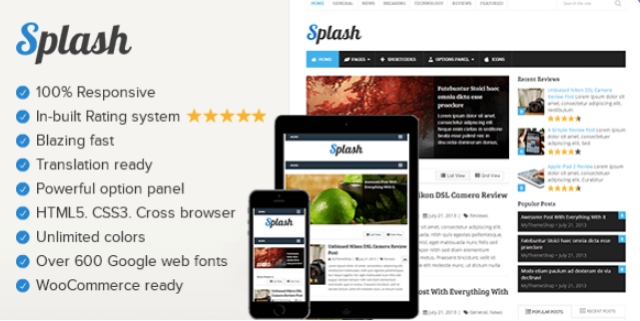Blogging Basics
Creating your WordPress blog: The ultimate guide to get you started

© Isaque Pereira / Pexels
WordPress is one of the most commonly used Content Management Systems for blogging. Over 60% of all blogs online run on WordPress. Its popularity can be attributed to the platform’s flexibility and user-friendliness.
First things first: What is WordPress?
WordPress is an open-source content management system (CMS), which is licensed under GPLv2. This essentially means that anyone can use or adapt WordPress software to suit their own needs for free.

As a CMS, WordPress is a tool that helps you manage all of the important components of your site, like content creation and layout. The best part? You don’t need to be a coding expert to use it.
There are a wide range of CMS platforms available online, so how do you know WordPress is right for you? As an open-source software, some versions of WordPress are free, which is certainly attractive to anyone looking to just test the waters of blogging.
Additionally, WordPress is constantly updated, with users creating plugins that will suit a multitude of tasks. Some of the most popular are even free, with site support tools like Yoast SEO and Contact Form 7 plugins both available without payment.

Created in 2003, WordPress is also more established than other CMS platforms. Bugs are rare and easily eliminated by regular updates. As for security, keeping your blog and site up to date reduces your chance of being hacked to virtually zero.
Software developers constantly update their products and address potential bugs, thus ensuring that you can protect your site by simply making sure you’re running the latest version of WordPress and plugins.
What do you need to set up your WordPress?
There are three key elements you’ll need to set up your WordPress blog:
- A domain name
- A web host
- A few hours to set everything up
How much does WordPress cost?
As an open source software, WordPress is freely available to download. However, to have your site online and hosted by WordPress, there may be some fees involved.

Whilst the cost of running WordPress is quite low, the main costs will come from monthly web hosting fees and domain name registration. These can vary depending on the platform but are usually quite low now that the market is crowded and prices are more competitive.
There are over 6000 themes available on WordPress but you can also opt to pay a bit extra for a customised theme. In the same vein, there are free plugins that will cover most of your needs but you can also choose to buy premium versions of plugins like Yoast SEO.
Finding the best website platform for your page
When choosing a platform your page, it is important to consider what you want to do with your site. In creating a blog, the obvious choice is WordPress, but it’s still worth understanding why it is the most popular choice for bloggers.

Over 34% of all websites are run by WordPress. The main draw for this platform is that it is reliable, powerful and user-friendly. Additionally, as a free and open-source website builder, you have more autonomy and control over your own page than on any other platform.
WordPress blogging advantages:
- You have total control over every aspect of your own site. If you would like to start as a blog, you can always expand to have other functions. This is the benefit of the platform being easy to tailor and flexible.
- You can enjoy free access to themes and site design. Users have created a library of thousands of WordPress themes and plugs, all of which you have the luxury of adapting to your own site needs. Additionally, page building is made easy with a simple drag and drop process.
- Your site is incredibly accessible, with WordPress available in dozens of languages and flexible enough to easily create multilingual pages.
However, there are some things to consider before taking the leap. Here are a few things you will need to be aware of before joining WordPress:
- You will need to manage your own site and content. While it doesn’t take long to familiarise yourself with WordPress as a CMS, it can seem a little technical to begin with.
- You need to make sure you’re up to date with all system and plugin updates. Your site security depends on this, so you’ll need to take heed of reminders and alerts on your WordPress dashboard. WordPress is essentially the operating system for your website. Just as you need to update your phone regularly for security purposes, you need to make sure your WordPress version and plugins are the latest.
- You will need to perform system backups regularly. On the off chance something happens to your page, it will be vital to have an up to date backup on hand.
How to use WordPress for blogging?
As the most popular home for blogs online, WordPress is actually pretty intuitive when it comes to using the platform for blogging. There are a few simple steps to cover but the process of using WordPress for your blog is quite straightforward.
Choose the best WordPress hosting
To make sure your blog is as accessible as it can be, you’ll need to make sure of two things: a good hosting service and a domain.
There are several hosting services on the market that bundle the hosting service and domain name together so you can buy them at one time. Before you sign up to any, you’ll need to consider three things:
- Speed – also known as your page loading time
- Uptime – this should be at least 99.94%
- Customer Support – as a beginner, you’ll need a team to help you with WordPress related questions.
Here are the top three ranked hosting services that could be right for you.
1. Bluehost

This is one of the most popular hosting services for bloggers. Bluehost’s uptime is 99.99% and well-rated support services. However, there is no option to pay monthly, so this can be somewhat of a commitment.

With a slightly lower uptime of 99.97%, HostGator hosts more than 10 million domains. They also have a simple one-click installation process for WordPress.
3. SiteGround

While this host has the best WordPress-specific support and is officially recommended by WordPress, their pricing structures are limited and it has a slower load time than competitors.
Set-up and installation
As soon as you have signed up with a web hosting service, you will receive the access information for your control panel (or cPanel). While there are a number of icons and file paths in the cPanel, you can ignore them for now and just select install WordPress.
After a few prompts, your host service will request your domain name and your site name. Then you’ll need a username and password for your site.
Once you’ve clicked through and signed up successfully, you’ll receive your admin link which will look a lot like this: http://yournewwebsite.com/wp-admin
Select a theme
When you first log on, your site might look a little bland. The visual aspects of your blog is dictated by a theme. While customising your blog is an important step, it is important to not go too over the top.
Additionally, to save time you can use any of the thousands of pre-made themes already available online. To change your theme, all you need to do is go to your WordPress dashboard and click on Appearance and then Themes.

After selecting “add new,” you can search through the current free themes available and sort them by reviews, blog type and most popular. Preview whichever theme catches your eye by selecting it and seeing how it will look on your own site.
As mentioned, while it can be overwhelming to have such a range of choice, it is important to keep things simple. You can always add more if you feel like it but starting with a clean and simple layout will help your audience navigate your page more easily.
After installing and activating your theme, choose to customise it if you would like to make a few small tweaks. Otherwise, you have your framework ready to house your new content.
Add content
To start your first blog, head to your WordPress dashboard and select Posts from the sidebar menu. After choosing Add New, you will now see the post editor page where you can enter text and graphics for your first article.

After you have finished writing, make sure you have formatted the text well enough that is easy to read and has clear headings for your audience. Additionally, it’s worth compressing the images you have chosen, so your page’s load time isn’t increased unnecessarily.
Before you publish, you can add several features like Tags and Categories. These help organise your posts and make them easier to find for your readers. Once you’re done writing, go ahead and click on the Publish button on the right to publish your first blog post to the world.
The best WordPress blog examples for affiliate marketing
As WordPress comprises almost a third of the internet’s active sites, there are a number of variations of how affiliate marketers can use the site to best represent themselves. While it is easy to add affiliate links to any theme or layout in WordPress, it does make sense to select a theme that has been custom designed for this purpose.
A common feature is the capacity to produce professionally styled reviews. These will have photo reels, star ratings and product comparisons. Before you select your WordPress theme, here are our top three recommendations for blog with affiliate marketing components.
1. REHub

Created with the goal of covering anything a commercial blog could want in a blog theme, REHub offers a variety of product display options. It is also incredibly easy to add reviews, product comparisons and galleries to your WordPress site.
This theme is also worth considering for those who wish to sell their own products online, in addition to affiliate marketing. By using plugins like WooCommerce, you can list your own items alongside promoted products to optimise your site profits.

It’s important to decide whether you would like to follow the classic blog scroll-down format, the online store design or arrange things in a magazine layout. This theme allows you to choose which you would prefer, but if you are just getting started, the classic blog structure may be easiest.
Most importantly, there are a few affiliate-related plugins that will help you with tasks like creating product comparisons, as well as managing your external affiliate links. The latter will assist you in keeping track of how many clicks your links receive and can even redirect the user to new pages, all controlled from your main dashboard.
For anyone considering publishing reviews, product comparison tables are a great addition and make any differences clearer to your readers. They will also be more inclined to treat your site as a well-rounded information source and be less-inclined to navigate away to another site. This will ensure you benefit from any affiliate links you have in these sections.
2. Splash

With a clean and simple design, this theme is a good choice for anyone who just wants the basics. As there is an inbuilt rating system, adding interactive features to your site is made easier and will ensure your visitors return for engaging content. Additionally, there is a wide range of templates, so you can tailor the simplified design to your own needs.
If you have success with affiliate marketing links and you would like to expand into selling your own inventory, there is also the ease of adding in the popular WooCommerce plugin.
For bloggers who want to keep their content clean and straight to the point, this theme provides a flexible design and user-friendly interface.
3. Engine

To give your blog a less overtly commercial feel, magazine-style themes are a good choice. These balance content like product reviews or announcements with more informative sections like advice or knowledge sharing pieces. Engine is a good example of this type of theme, as it specifically designed for publishing a balance of review and news content.
If you have a busy publishing schedule, a magazine layout also makes sense. Visitors will immediately have a broad overview of your articles. After selecting a post, the widgets along the side of the page will suggest trending or popular articles. This is an effective tool in ensuring your visitors continue to click through on your page.
With a drag and drop editing tool, this theme is customisable and perfect for blogging beginners. There is no need to use code at any point. Additionally, there are affiliate-specific plugins and widgets available that balance well with non-commercial content, rather than overwhelm your audience.
Conclusion
After following our steps, you should have your very own WordPress blog, with a theme installed, and perhaps even some extra plugins. If you are feeling adventurous, try one of our recommended affiliate-friendly themes, too!
Now you’re ready to finally make a start on curating your own unique space online. Your blog is your chance to make connections, express yourself and, if all goes well, earn a passive income with content creation and affiliate marketing.
